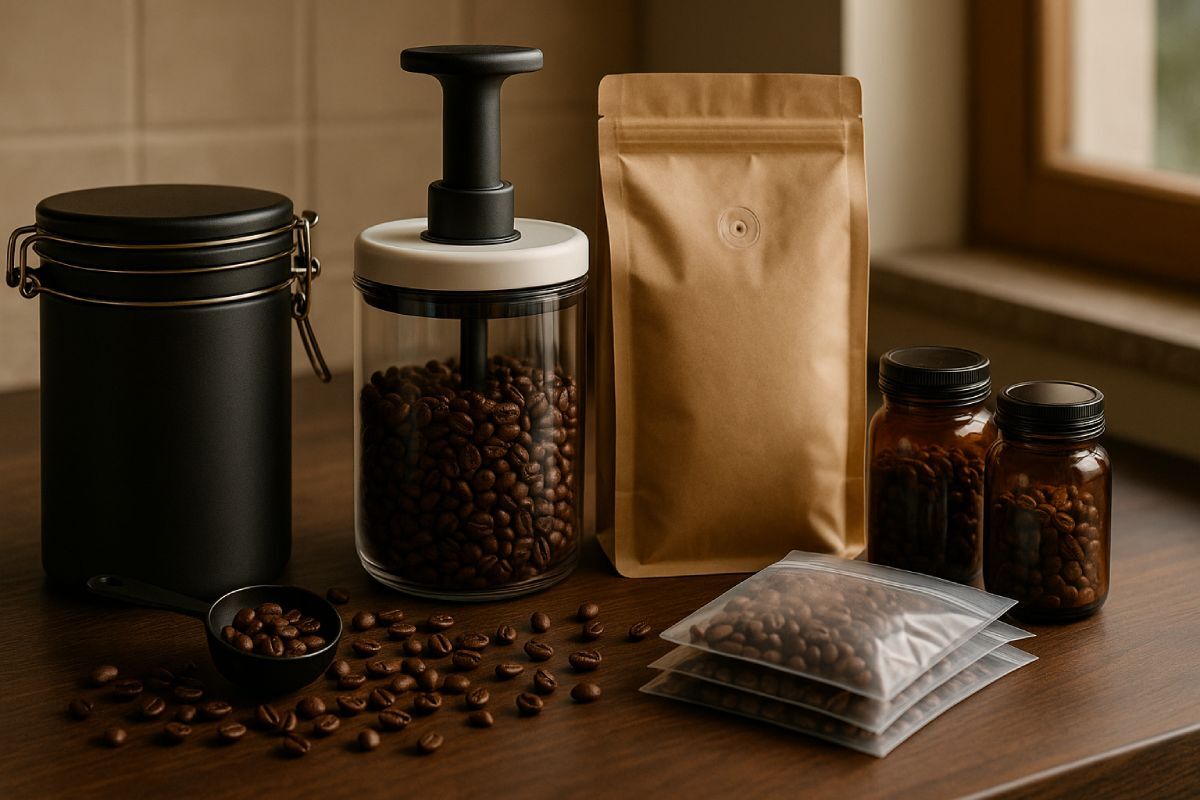
You've invested in high-quality coffee beans, brought them home, and are looking forward to a delicious cup. But how you store those beans between brews is one of the most critical—and often overlooked—factors in preserving their flavor and aroma. Improper storage can turn even the most exquisite coffee into a flat, stale, and disappointing experience.
The moment coffee is roasted, it begins a journey of staling. While this process is inevitable, you can dramatically slow it down by protecting your coffee from its four greatest enemies. This guide will teach you the golden rules of coffee storage to ensure every cup is as fresh and flavorful as possible.
The 4 Enemies of Coffee Freshness
To keep coffee fresh, you must protect it from four key elements that cause it to degrade rapidly.
- Oxygen: Oxidation is the primary enemy. Just like an apple turns brown when exposed to air, coffee stales and loses its vibrant flavors when it comes into contact with oxygen.
- Light: UV rays from sunlight and even indoor lighting can break down the delicate oils and aromatic compounds in coffee, leading to a loss of flavor.
- Heat: Heat acts as a catalyst, speeding up the chemical reactions that cause coffee to go stale. Storing coffee near a stove, oven, or sunny window is a recipe for flavor loss.
- Moisture: Coffee is hygroscopic, meaning it absorbs moisture, aromas, and flavors from the air around it. Moisture can ruin the integrity of the roasted beans and even lead to mold.
The Golden Rules of Storing Coffee
Based on coffee's four enemies, here are the essential rules for proper storage.
Rule #1: Store Coffee in an Airtight, Opaque Container
The best way to combat oxygen and light is to store your beans in a container that blocks both. Look for containers made from non-reactive materials like ceramic or stainless steel. While glass containers can be airtight, choose an opaque or UV-protected version to keep light out. For freshly roasted beans, a container with a one-way CO2 valve is ideal, as it allows the beans to degas without letting oxygen in.
Rule #2: Keep It in a Cool, Dark, Dry Place
Your pantry or a cool cabinet is the perfect home for your coffee. It protects the beans from heat sources and direct sunlight. Avoid storing coffee on your kitchen counter, especially if it gets direct sun, or in a cabinet directly above your stove or oven.
Rule #3: Buy Whole Beans and Grind Just Before Brewing
Pre-ground coffee stales exponentially faster than whole beans because its massive increase in surface area exposes more of the coffee to oxygen. For the freshest possible cup, always buy whole beans and grind only what you need immediately before brewing.
Rule #4: Buy the Right Amount
Treat coffee like fresh produce. It's best enjoyed within a few weeks of its roast date. Buying smaller quantities more frequently ensures you're always brewing with beans that are at their peak flavor. Avoid stockpiling large amounts unless you plan to freeze it for long-term storage (more on that below).
The Great Debate: Should You Refrigerate or Freeze Coffee?
This is one of the most common questions, and the answer is nuanced.
Storing Coffee in the Refrigerator: Don't Do It!
The refrigerator is one of the worst places to store coffee. The cool, humid environment is a hub of condensation. Every time you open the container, moisture will condense on the beans, damaging their flavor. Furthermore, coffee readily absorbs odors, meaning your beans might end up tasting like last night's leftovers.
Storing Coffee in the Freezer: The Right Way
Freezing can be an effective method for long-term storage (more than one month), but it must be done correctly.
- Only Freeze Once: Never refreeze coffee beans after they have been thawed.
- Use an Airtight, Vacuum-Sealed Bag: Remove as much air as possible to prevent freezer burn and oxidation.
- Store in Small Portions: Divide the coffee into weekly portions so you only thaw what you need.
- Thaw Completely: Before opening the bag and grinding, let the beans thaw completely to room temperature. Opening it too soon will cause condensation to form on the frozen beans, ruining them.
The Verdict: The freezer is only for long-term storage of unopened bags. For daily use, the pantry is always the best choice.
Frequently Asked Questions About Storing Coffee
What is the best type of container for storing coffee beans?
The ideal container is opaque, airtight, and made of a non-reactive material like ceramic or stainless steel. For freshly roasted beans, a container with a one-way CO2 degassing valve is the gold standard, as it lets CO2 out without letting oxygen in.
Is it okay to store coffee in the original bag it came in?
It depends on the bag. If it's a high-quality, opaque bag with a one-way valve and a resealable zip-lock, it can be a good storage option. However, standard paper or thin foil bags offer little protection. For best results, transfer your beans to a proper storage container.
How long do coffee beans last?
Unopened, whole bean coffee stored properly can remain near peak freshness for about 2-4 weeks after the roast date. After that, it will begin to stale, though it's still perfectly drinkable for several more weeks. Ground coffee loses much of its flavor within a day of being ground.
Why is it so bad to keep coffee in the refrigerator?
The refrigerator creates two major problems for coffee: condensation and odor absorption. The humid environment causes moisture to collect on the beans, which ruins their flavor. Coffee is also porous and will absorb the smells of other foods in your fridge.
